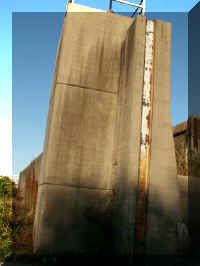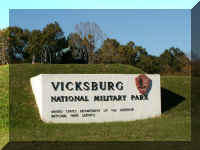
Louisiana, Mississippi and Alabama - 2006
Updated: 11/30/08
We decided to avoid the aftermath of hurricanes Katrina and Rita and take the northern route toward home. News reports and comments made in the official state travel books from the states involved all indicated the areas are not back to normal. Also, when we visit those areas, we will want to spend more time than we can give to them during this Fall of 2006 trip. By using the northern route and traveling in the off-season, we did not have many tourist opportunities available. Some had already closed for the season.
Louisiana Mississippi Alabama On the road . . .
We visited the home of Emy-Lou Biedenharn, daughter of Joseph A. Biedenharn, the first bottler of Coca-Cola. It has been turned into The Biedenharn Museum and Gardens at her request and is operated by the Biedenharn Foundation. The house contains all her furniture, decorations and personal belongs.
The first thing we saw after entering the porch was a marble fountain filled with bottled Coke. As Fred fired up the camera, the woman talking to us said, "Sir, no photographs". Like many museums, they had a no photograph policy. No matter how Fred teased the tour guide about how painful it would be to not make photographs, she just smiled. When she showed us the father's room of Coke memorabilia, she smiled at Fred and said, "this will be a hard room for you to see". She suggested we visit the Coca-Cola Museum in Vicksburg, Mississippi where photographs are permitted.
Their policy did permit photographs of the outside gardens. We made twenty or so photographs outside. While processing the photograph that evening, Fred accidentally deleted the directory instead of one selected photograph. Now, Mary Lou knows for sure that Fred does not like anything associated with garden work.
The tour was nice, the history of the Joseph A. Biedenharn family is very important to the local residents. The tour took about an hour and a walk through the gardens took a half-hour. There was no admission charge, donations would be accepted.
In the garden, we bought a bottle of Coke from a vending machine for 5-cents.
Vicksburg National Military Park
In 1899 this area was established as a national military park. It is on the site of the 45 day struggle for control of the Mississippi River during the Civil War.
As you drive the sixteen mile 'driving tour' the magnitude of the battle field is evident. Along the road and on the grounds, signs are posted telling the story of the action that occurred at that spot. Names of the soldiers, the unit and other information available was recorded and made part of the history.
Signs were painted in blue for the Union soldiers and red for the Confederate soldiers indicating where their respective lines or emplacements were.
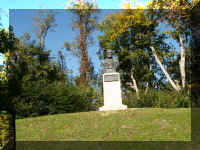
They were placed at locations significant to the battles. Because the soldiers from the states were in battles at many locations, the states have provided many monuments.
These statues are of Jefferson Davis and Ulysses S. Grant.
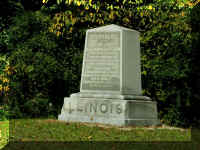

Near the Illinois monument is the Shirley House. It is the only surviving wartime structure in the park. During the siege it served as the headquarter of the 45th Illinois infantry.
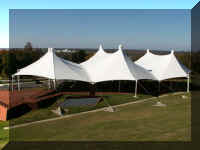
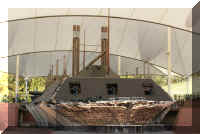
You can see on the left side of the bow where the torpedo hit.
Fort Hill was located on a high hill overlooking the Mississippi River. Because of it position, the Union Army did not attack it.
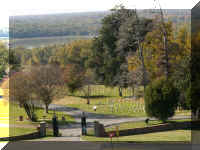
The Visitors Center is open from 8am - 5pm daily. The drive-through gate is open 8am - 5 pm daily. The admission charge of $8.00 per private vehicle is good for 7 days.
Museum of Coca-Cola History and Memorabilia
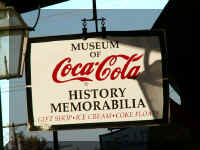
The building began as a candy store. In the drug store today, you can tour the museum, purchase memorabilia and enjoy a Coke float.
The bottle size and shape has changed over the years. What started as a six ounce drink for a nickel, now is sold in much larger bottles - for more than a nickel.
How coke is dispensed to the customer has changed also. The small party size dispenser and the large retail model are on display. The large dispensers could be very fancy and sell for up to $5,000.
Paper and wood cartons were the most popular. The little cardboard six-pack being the one we remember most.
We have a flat wood rack in our collection of Coke stuff.
Remember when small quantities of Coke were displayed on wire racks instead of stacked on shelves?
There were also a number of metal cartons.
Of course, they displayed specialty items like Coke Barbie and a Coke camera.
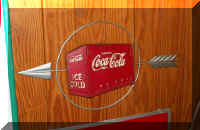
Wall hangings . .
.
Small baskets . . .
Coolers . . .
This child's high chair was
in the vintage soda fountain.
Here are photographs of some of the display cases in the museum.
We spent about and hour at the Coca-Cola Museum. Admission was $2.75 for adults.
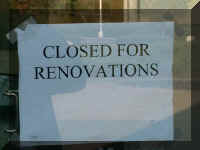
The entire complex was in white and landscaped very nicely.
The assembly plant and fountain . . .
A significant amount of the space
was tracing Gottlieb Diamler's life.
Vehicles and other displays of engine and transmission technology were on display. One vehicle was signed by employees to commemorate some milestone.
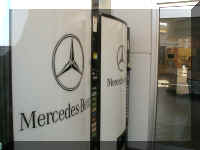
This Vicksburg city park is near the Mississippi River.
